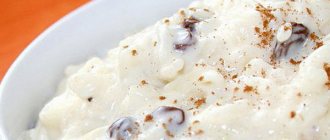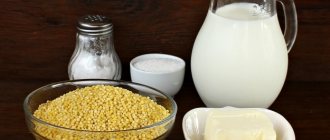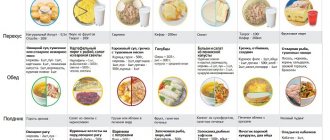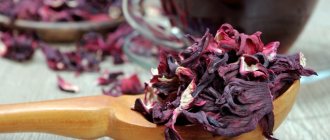Useful video about semolina porridge for children
Today, complementary foods are introduced to children at 6 months.
And if earlier doctors recommended doing this with juices and fruit purees, now porridge has become the first new food. Since the child’s digestive tract is able to absorb it well and quickly, which cannot be said about fruits and vegetables. The first porridge that parents remember is semolina. But questions immediately arise about the advisability of its use, because pediatricians are in no hurry to recommend it to new parents.
Advantages of semolina:
- This cereal contains a large amount of vitamins. The most valuable of them are vitamin B2, PP, E, B9 and B.
- It contains a lot of protein, which a child needs during growth.
- It also contains minerals such as magnesium, calcium, potassium, iron, phosphorus, sodium, etc.
- Cereals mostly consist of starch, which is a source of energy.
- This porridge undergoes heat treatment for a minimum time, which allows it to retain all its beneficial properties.
- Semolina is a very satisfying product. This fact is invaluable for those children who can no longer receive mother’s milk in full.
Disadvantages of semolina:
- It contains gluten. It is not recommended to give porridge with gluten to babies under one year of age, as an allergy to it or simple gluten intolerance may occur. Due to the immaturity of the intestines, semolina porridge is contraindicated for children under one year of age.
- Semolina also contains phytin, which can reduce calcium levels in a child’s body. Although it also has a positive effect - it exhibits antioxidant properties.
- Semolina prevents vitamin D and iron from being absorbed. And these elements are extremely important for a growing organism.
- Cereals contain glyodine, which blocks the absorption of nutrients into the intestinal walls.
Children under three years old should cook the dish with milk diluted with water. The recipe is for 1 serving:
- 130 ml milk;
- 130 ml water;
- 4 teaspoons semolina;
- sugar or honey.
Pour milk and water into a saucepan and boil, add sugar or honey to taste. Then, stirring constantly, add 4 teaspoons of semolina, previously sifted through a small sieve, and let simmer for 2 minutes. You need to stir very well so that no lumps form in the porridge. Remove from heat and let sit for 10 minutes. Done, you can add a piece of butter, this will give it a more delicate taste.
If the child is over three years old, then you can cook porridge with milk alone.
This cereal is made from wheat, it is a kind of coarse wheat flour. In baby food, semolina has both advantages and disadvantages. The advantages include its energy value, it is nutritious and high in calories (100 g of cereal contains 360 kcal), and promotes weight gain in premature or weak children. This product is available to everyone, is easy and quick to cook, and is inexpensive.
What power is in this dish:
- proteins necessary for growth;
- carbohydrates (including large amounts of starch, which provides energy);
- vitamins of group B, PP;
- micro and macroelements necessary for the child’s body.
Semolina is nutritious and healthy
Semolina porridge contains substances that can cause a negative reaction in the baby’s body:
- gluten is a protein found in wheat (rare, but there are allergies or intolerances to it);
- phytin is a salt that interferes with the absorption of calcium, iron, and vitamin D, which can lead to rickets.
In the store, you need to be able to choose the right semolina:
- GOST, brand T or TM must be written on the packaging (this means that the cereal is made from durum wheat or a mixture of durum and soft);
- It is better to take a transparent pack, it shows the quality of the product (cream shade, absence of lumps and black dots);
- pay attention to the shelf life;
- give preference to well-known manufacturers.
Semolina is just ground wheat, and there is so much controversy surrounding it about its effect on the body! Semolina porridge with milk is a classic baby food in the USSR; young mothers were recommended to use it as complementary food from the age of one month.
There are useful substances in semolina, it is not that bad. It is easily absorbed by the child’s body; thanks to quick preparation, all vitamins are preserved unchanged.
The composition of semolina includes:
- Vitamin B, folic acid, which have a good effect on the functioning of the nervous system;
- carbohydrates (quickly saturate with energy and are easily digested);
- calcium and silicon (have a positive effect on the development of the bone apparatus).
Once in the body, semolina reliably envelops the walls of the digestive organs.
Thanks to the large amount of carbohydrates, it is introduced into the diet of exhausted children, as a result of which they quickly gain strength. Just because of this amount of carbohydrate (70 g/100 g of cereal) and the small amount of fiber in the composition, many mothers are at a loss, not knowing whether to give semolina to their children or not.
Semolina contains substances without which it would be more valuable.
For example, gluten. You definitely need to check whether your baby is intolerant to this type of protein, because it is found in many grains.
Phytin is the second harmful substance contained in semolina; it makes it difficult for calcium to enter the body.
As a result, we have only two reasons to refuse semolina porridge - gluten intolerance and a decrease in calcium in the body with frequent consumption of the dish. Semolina porridge is not useless, you just need to correctly introduce it into the diet, do not forget about the minimum frequency of use and do not start offering it to a child under one year old.
Despite its low nutritional value and allergy risk, semolina is beneficial for premature and low-weight infants. In these cases, pediatricians advise including semolina in complementary foods from the age of five/six months. How is semolina useful?
It includes:
- vegetable protein;
- starch;
- vitamins E, PP and B.
The benefits of protein are known - it is a building material for the growing baby’s body.
Starch is an excellent source of energy for active children.
Semolina is also useful for its calorie content: it gives a feeling of satiety to children under one year old, for whom breast milk alone is no longer enough.
It can be given as complementary food. Cooking porridge does not take much time, so all the beneficial substances remain in the finished product.
Recipe for making semolina with milk for a child
Semolina porridge is one of those cereals around which there is constant and tireless debate. If previously it could be given from infancy, now pediatricians strongly advise against feeding babies semolina too early. The fact is that this cereal has few beneficial properties, but it can cause harm to the baby.
However, despite numerous prohibitions, parents continue to feed their children such a tender, tasty, milky porridge. Those children who are overweight should not eat semolina often. In addition, overuse of semolina porridge can cause excessive gas formation, colic, and constipation in a child.
Cooking technology
As you can see, it is better to prepare semolina for babies over one year old. To do this, you need to use a proven recipe. Despite the prohibitions, semolina porridge is an unusually tasty, healthy dish that can give energy and strength not only to small children, but also to adults.
| Milk | 1 glass |
| Semolina | 3 spoons |
| Butter | 10 grams |
| Sugar, salt | taste |
| Jam, honey | optional |
1. Turn the heat to medium. Pour a glass of fresh milk into the pan.
2. Add sugar and salt in the required amount. If you don’t want your porridge to be too sweet, just add 1.5 teaspoons of sugar.
3. Place the pan with milk on the stove. Make sure it doesn't run away. Do not bring the milk to a boil. When a slight bubbling begins, add semolina. Add it in a thin stream, stirring constantly, this will help avoid the formation of lumps.
4. Housewives should take note that after adding semolina, they should make sure that there is enough of it for a serving of milk. This is extremely important, since the thickness of the future dish depends on the proportion of components. The grains should float freely. Cook for two minutes, stirring.
5. Semolina porridge with milk is ready when the consistency becomes slightly thick. In addition, its color should change, namely, become creamy.
6. If you wish, you can add a little butter (82% fat).
7. Serve in a portioned plate; you can garnish with jam or honey. It will be very tasty and appetizing.
recipe
The proposed recipe will help you prepare the most delicious and healthy porridge for your baby. There is no need to cook it more than once a week.
The benefits and harms of semolina for children
If you don’t know how to cook semolina with milk for a child, then you will need a good recipe. Despite the fact that semolina is very healthy, light and airy, pediatricians say that it can only be eaten by children over ten months old. As for the first complementary foods, it is better to give preference to gluten-free porridge options:
- corn;
- buckwheat;
- rice
According to numerous studies, children under six months do not need additional complementary foods!
Milk semolina porridge is dietary because it does not contain very much dietary fiber. However, there are also disadvantages. It contains a fairly large amount of vegetable protein (gluten), and the infant’s body has difficulty digesting it.
In simple words, a baby is not able to digest gluten. As for nutritional value, it contains very little mineral salts, healthy fats and vitamins. This porridge contains about seventy percent starch.
If a child’s body can get used to such an amount of carbohydrates, this will provoke fat folds and excess weight.
As for gluten, gluten, the immature digestive system of a baby under one year old is not able to digest it. As a result, the baby develops a rash and allergies on the face. A special substance predominates in grains - phytin, which interferes with the absorption of important vitamin D and calcium.
Semolina contains another unsafe element, namely mucopolysaccharide, which is a false biopolymer. What is its harm? Basically, it glues together the villi located in the children's intestines, and this can cause their necrosis. This provokes improper absorption of nutrients by the child’s intestines.
The use of milk semolina porridge as an early complementary feeding can provoke various pathologies of the gastrointestinal tract, cause a weak immune system and rickets. To avoid serious problems and complications, it is not recommended to frequently feed your child this dish until the age of three.
Source: https://vashakasha.com/mannaya/na-moloke-dlya-rebenka.html
Why can't you give it before a year?
Here it would seem that one should think of semolina as a tender, easily digestible and high-calorie product. Especially semolina would become an indispensable food for children who are slowly gaining weight. However, modern technologies have made it possible to reconsider the composition of semolina and identify new features in it.
Why semolina is good
- Rich in carbohydrates, in particular starch, which provides the body with energy.
- It contains a minimum of proteins, and this is useful for chronic kidney diseases.
- Contains vitamins (especially valuable groups B, E, PP) that are indispensable for a growing body.
- Semolina contains the necessary minerals - magnesium, potassium, phosphorus, calcium, iron.
- It is cooked a little, so all the beneficial properties are preserved.
- High calorie and satiating dishes made from semolina, which is necessary for children who are slowly gaining weight.
Undesirable properties
- Semolina, like other wheat cereals, contains a substance called mucopolysaccharide (gliadin). It is dangerous because, when regularly introduced into the intestinal tract, it can cause necrosis (partial death) of the villi in the intestine, which are responsible for the absorption of nutrients. This provokes the development of such diseases: gastritis, colitis, oncological pathologies.
- Semolina contains phytin, a substance that interferes with the absorption of vitamin D, calcium, and iron. And they are indispensable for a child’s health: their deficiency leads to rickets and anemia.
- Gluten in semolina can cause allergies or celiac disease (intolerance to gluten, which is found in all grains). At an early age, due to intestinal immaturity, the risk of intolerance is much greater.
- It is good to cook semolina porridge with cow's milk, but it is not recommended to give it to children under one year old (sometimes even up to three years old).
- Due to its calorie content, semolina is contraindicated for infants, who are already gaining weight well. This leads to paratrophy (obesity).
Due to the above factors, it is not advisable to include semolina in the menu of children under 1 year of age, and up to three years of age it should be consumed in moderate portions. But don't go to extremes. Persistent negative complications arise only in cases where the baby does not consume anything else other than semolina or eats it regularly as complementary foods. If semolina porridge appears on the menu once every fourteen days for variety, the child will not develop health problems.
When breastfeeding, it is recommended to introduce complementary foods when the baby is six months old and only needs mother’s milk. In this way, he is gradually prepared for adult food. Semolina porridge is not a product that should be introduced into complementary foods for a healthy baby. It can strengthen or weaken the child.
There is also a porridge that children grew up with in the last century - bearberry, the ancestor of modern instant mixtures. Oatmeal is a type of flour that is made from peeled, steamed oat grains. They are not ground, but crushed. The oatmeal does not need to be boiled, but simply steamed with boiling water and/or milk. At the same time, all useful qualities are preserved.
Pediatricians recommend introducing semolina porridge into complementary foods no earlier than the child turns 8 months old, and preferably a year. At this age, porridge will not become heavy food for the baby and will be normally absorbed by the child’s body. It is recommended that children under three years old be given semolina porridge no more than once a week. Complementary feeding must be correct, in compliance with all norms for the usefulness of foods for a one-year-old child.
Like any new product, semolina should be included in the menu little by little and gradually, observing the child’s reaction. The first time it is better to cook the porridge in water and let it taste one teaspoon. If the baby does not develop rashes or bowel movements, then gradually increase the amount, bringing it to a full portion for one meal. Semolina contains a lot of gluten and little fiber, so it can cause constipation.
Semolina porridge is introduced into the baby’s diet gradually so that it does not cause allergies.
If there is a need to feed the child semolina earlier, then two- and three-month-old children are fed rare porridge, 5% (5 g of cereal - less than a teaspoon per 100 g of liquid). After 6 months they make it thicker, 10% (10 g of cereal - a heaped teaspoon per 100 g of liquid). Be sure to discuss feeding your baby with your pediatrician.
When semolina porridge is introduced into a child’s diet, it can be boiled in water and milk in equal proportions. What time of day (for breakfast or dinner) doesn’t really matter. But sometimes doctors advise, if the baby does not sleep well and wakes up at night demanding food, to feed him before bed. Semolina is very nutritious, maybe he will be satisfied and sleep peacefully.
Semolina porridge is the very first porridge that parents give to their child. It is very filling and tasty. Semolina can be prepared with milk, water, using dried fruits and fruits. There are a lot of cooking options, but today we will prepare Semolina porridge according to the classic recipe.
Porridge norms for 1 year
What to feed a baby at 8 months
Although semolina porridge is considered a healthy dish, it has a number of contraindications. Thus, it impairs the absorption of calcium and vitamin D, which are necessary for a growing child’s body. Due to the large amount of semolina, iron is not absorbed in full. That is why the introduction of porridge is delayed for up to a year. Even then, you should adhere to the recommended standards so as not to harm the little person.
Serving Size
The serving size per year does not exceed 180-200 grams. There is no need to force a child to eat. It’s not scary if he gets less food one day and more on another.
The baby eats porridge by himself
Note! When your little one tries semolina porridge for the first time, you should offer him half a teaspoon. For the first complementary feeding, you need to take 5 grams of cereal per 100 milliliters of liquid.
If the baby responds normally, you can increase the dose without adding other new products at this time. If you observe undesirable reactions, such as skin rashes or stool disorders, you should postpone the introduction of the product for at least a month.
How often to feed
Until the age of three, you should not give semolina to your child more than once a week. If the baby is not inclined to be overweight, then you can offer the dish twice in 7 days.
Semolina porridge is a popular breakfast option for children and adults. It should be offered to a child only after one year, so as not to harm the body. The digestive system of a one-year-old baby is ready to meet a new ingredient. Different cooking methods will help diversify a dish familiar from childhood. Fruits and vegetables added to porridge will not only create a new taste, but also provide additional benefits.
Step by step recipe
| To prepare semolina porridge we will need the following products: |
| Place a small saucepan on low heat and pour in the milk. Bring the milk to a boil (10 minutes), stir occasionally, as milk burns quickly. |
| Sugar must be added to milk. The amount of sugar depends on taste preferences. Since I am preparing porridge for my daughter, and she likes it sweeter, I add 2 tablespoons. Stir the sugar thoroughly until completely dissolved. |
| Semolina must be finely ground; such semolina produces a very tender porridge. Add semolina one spoon at a time, after each spoon the porridge must be stirred thoroughly so that no lumps form. |
| We constantly stir the kush, preventing it from sticking to the walls of the dish. You need to cook the porridge for 10 minutes so that the cereal is completely boiled. |
| Turn off the heat, cover the porridge with a lid and let it brew for 20 minutes. Pour the prepared porridge into bowls, adding a piece of butter to each bowl. Butter added to porridge promotes better digestion. Bon appetit! |
What is semolina
Essentially, semolina is ground wheat.
Semolina consists of small particles of the endosperm of wheat grains, in other words, semolina is ground wheat. The size of the grains varies between 0.2-0.6 mm. Semolina is obtained from soft, hard and mixed varieties of wheat. Only soft grains are suitable for porridge. “Hard” cereals are added to soups, cutlets, casseroles, etc.
How long to cook semolina porridge for a child
The ideal semolina is when the porridge is not overcooked, so it will retain all the vitamins and useful minerals.
When cooking, the cereal should always be poured only into the boiling liquid, and this should be done very carefully, slowly, stirring gradually. It is this manipulation that will protect your porridge from unpleasant lumps in it.
Before boiling the milk, you can rinse the pan with cold water or add a couple of ice cubes; this will help prevent the milk from burning.
The proportions of milk and semolina in semolina porridge are the main condition. The final consistency of the dish depends on the correct ratio of ingredients.
| Porridge liquid level | Cereals (quantity) | Liquid (volume) |
| Very liquid (in a bottle) | 2 teaspoons | 1 glass |
| Liquid (can be eaten with a spoon) | 1 tablespoon | 1 glass |
| Medium liquid | 2 tablespoons | 1 glass |
| Thick | 3 tablespoons | 1 glass |
When choosing cereals, look at the package labeling. There are three varieties of semolina:
- "T" durum wheat.
- "M" soft wheat.
- “MT” is a mixture of two varieties of wheat.
To prepare delicious porridge without lumps, the best option is “M”.
Semolina cooked in water has 80 kcal per 100 g, and in milk - about 100 kcal. The cereal should always be poured in little by little, in a thin stream, stirring continuously with the other hand to avoid lumps. The proportions of proper medium-thick semolina porridge are 1:5, that is, per 100 g of cereal you need 0.5 liters of liquid. Pour milk or water into the pan, after boiling, turn the heat to low, add semolina, cook for 4-7 minutes depending on the type of cereal.
Composition of cereals
Semolina contains more than two dozen useful components necessary for the normal functioning of the body.
For 100 g of semolina there is:
- 67.4 g of carbohydrates (the main part of them is starch);
- 14 g water;
- 10.3 g protein;
- just one gram of fat.
Semolina also contains ash substances, dietary fiber, vitamins (PP, E, B2, B6, B1, folic acid), microelements (potassium, phosphorus, sulfur, chlorine, calcium, magnesium, iron, zinc, fluorine, chromium, molybdenum , vanadium, silicon, etc.).
However, when compared with other cereals (buckwheat, oatmeal, rice), it turns out that in terms of the content of microelements and vitamins, semolina “loses” to them by 3-5 times.
Original recipe: semolina porridge with chicken broth
How many people associate semolina with a sweet dish? Various puddings, semolina porridge with jam, honey, sweet syrups. Why not make this grain for lunch as a second meal?
Products:
- semolina “M” 2 full tablespoons;
- 1.5 cups chicken broth;
- chicken breast;
- butter;
- salt, herbs to taste.
Add finely chopped boiled meat (200 grams) to the pan with chicken broth and bring to a boil. Stirring constantly, slowly add the cereal and cook for a couple of minutes, without stopping stirring, do not forget to add salt to our dish, cook for another 7 minutes over low heat.
Add greens.
Ready!











